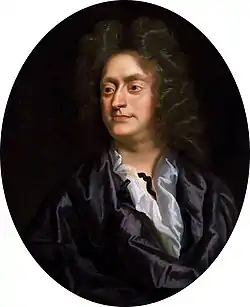Hear my prayer, O Lord (Purcell)
"Hear my prayer, O Lord", Z. 15,[1] is an eight-part choral anthem by the English composer Henry Purcell (1659–1695).[2] The anthem is a setting of the first verse of Psalm 102[2] in the version of the Book of Common Prayer. Purcell composed it c. 1682, at the beginning of his tenure as Organist and Master of the Choristers for Westminster Abbey.
| "Hear my prayer, O Lord" | |
|---|---|
| Anthem by Henry Purcell | |
 Portrait of the composer by John Closterman, 1695 | |
| Key | C minor |
| Catalogue | Z. 15 |
| Genre | Sacred choral music |
| Text | Excerpt from the Litany from Book of Common Prayer |
| Language | English |
| Composed | c. 1682 |
| Scoring | SSAATTBB choir, optional continuo |
History and music
The composition is thought to have been intended to be part of a longer work, indicated by several blank pages following it in the autograph, which is held by the Fitzwilliam Museum in Cambridge.[2] The lyrics of the extant music are the first verse of Psalm 102: "Hear my prayer, O Lord, and let my crying come unto thee." (Psalms 102:1). Purcell set it for an a cappella choir consisting of eight voice parts: two soprano parts, two altos, two tenors and two basses (SSAATTBB). The anthem is 34 measures long, and is written in the key of C minor. Some arrangements include a continuo instrumental accompaniment. Musicologist and historian Franklin B. Zimmerman designated the anthem as "Z. 15" in his catalogue of Purcell's works.[1] The duration of performances and recordings of this work varies considerably, from about two minutes to over three minutes in length.[3][4][2]
Purcell begins the composition with a simple setting of the first line on one tone, with only one exception, a minor third up on the word "O". After the first phrases, Purcell employs six to eight parts, in complex "pungent"[5] harmonies which build to what the conductor Robert King calls "an inexorable vocal crescendo lasting over three minutes, culminating on a monumental discord on the last repetition of 'come'".[2] Musicologist Timothy Dickey notes that Purcell "gradually amplified the vocal texture, and intensifies the harmonic complexity, until all eight voices combine in a towering dissonant tone cluster which desperately demands the final cadential resolution."[5]
The anthem has been recorded many times,[2] including a 1995 release by the Collegium Vocale Gent, conducted by Philippe Herreweghe,[3] and one from 2006 by the Choir of Clare College Cambridge, conducted by Timothy Brown.[4]
Legacy
The Swedish composer Sven-David Sandström used this piece for a composition of the same name, wherein, just shortly before the final cadence, the pieces collapses and builds up again from small bits of melody from the original.
References
- Zimmerman, Franklin B. (1963). Henry Purcell 1659–1695: An Analytical Catalogue of his Music. London: MacMillan & Co.
- King, Robert (1992). "Hear my prayer, O Lord, Z15". Hyperion Records. Retrieved 27 August 2017.
- "Henry Purcell Funeral Sentences". AllMusic. Retrieved 27 August 2017.
- "Purcell Choral Works, Te Deum, Jubilate Deo & more". AllMusic. Retrieved 27 August 2017.
- Dickey, Timothy. "Henry Purcell / Hear my prayer, O Lord, anthem for chorus, violins & continuo, Z. 15 (unfinished)". AllMusic. Retrieved 3 September 2017.